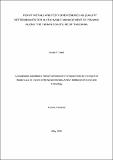| dc.contributor.author | Patiri, Gloria | |
| dc.date.accessioned | 2020-11-25T12:18:19Z | |
| dc.date.available | 2020-11-25T12:18:19Z | |
| dc.date.issued | 2020-05 | |
| dc.identifier.uri | https://doi.org/10.58694/20.500.12479/1040 | |
| dc.description | A Dissertation Submitted in Partial Fulfillment of the Requirements for the Degree of
Master’s in Life Sciences of the Nelson Mandela African Institution of Science and Technology | en_US |
| dc.description.abstract | The presence of heavy metals and pesticide residues in prawns, water and sediments, were
determine. Prawns, sediments and water samples were collected along prawns fishing zones
in the Indian coastline of Tanzania. Zinc (Zn), lead (Pb) and cadmium (Cd) were analyzed
using Atomic Absorption Spectrophotometry (AAS). Direct Mercury Analyzer (DMA) was
used for mercury (Hg) analysis. Pesticide residues were analyzed by Gas ChromatographyMass
Spectrophotometry
(GC-MS). Information on stakeholder’s perception on the sources
of aquatic pollution was collected using a structured questionnaire. Results indicated that,
fertilizer (60.7%), pesticides (59.8%) and herbicides (60.7%) were the main sources of
aquatic pollution. Cyberdip and Utupa-mixed local herbs were the chemicals used in prawns
fishing. Heavy metal contaminants were predominant in sediments followed by prawns, and
water. The heavy metals were highly concentrated in prawns and sediments in the order of Zn
> Pb > Cd > Hg, and Pb > Zn > Cd > Hg in water respectively. Lambda-cyhalothrin was the
only pesticide residue detected in prawns and sediments but not in water. Lambdacyhalothrin
levels
detected
in
prawns
from
Kisiju
and
Kilwa
were
5.6
–
45.2
folds
above
the
maximum
acceptable
limits.
Lambda-cyhalothrin
levels
in
sediments
was
175;
4070
and
4432
folds
higher
than
the
maximum
acceptable
level
in
Bagamoyo,
Kilwa
and
Kisiju
respectively.
Presence
of Zn, Pb and lambda-cyhalothrin beyond acceptable limits in prawns and
sediments may indicate marine pollution. The maximum acceptable level of lambdacyhalothrin
in sediments is 0.00372 mg/kg and the maximum acceptable level of lambdacyhalothrin
for prawns is 0.05 mg/kg. These pollutants may impair quality and safety of
prawns and by-products which is a risk to the public health. Therefore, monitoring of
agricultural and the anthropogenic activities around prawn fishing areas is inevitable. | en_US |
| dc.language.iso | en | en_US |
| dc.publisher | NM-AIST | en_US |
| dc.rights | Attribution-NonCommercial-ShareAlike 4.0 International | * |
| dc.rights.uri | http://creativecommons.org/licenses/by-nc-sa/4.0/ | * |
| dc.subject | Research Subject Categories::NATURAL SCIENCES | en_US |
| dc.title | Heavy metals and pesticide residues as quality determinants for sustainable management of prawns along the Indian coastline of Tanzania | en_US |
| dc.type | Thesis | en_US |


